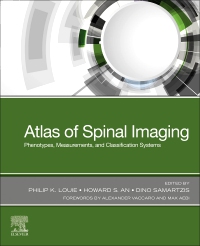
Atlas of Spinal Imaging, 1st Edition
Paperback

Now $84.99
Spine-related pain is the world’s leading disabling condition, affecting every population and a frequent reason for seeking medical consultation and obtaining imaging studies. Numerous spinal phenotypes (observations/traits) and their respective measurements performed on various spine imaging have been shown to directly correlate and predict clinical outcomes. Atlas of Spinal Imaging: Phenotypes, Measurements and Classification Systems is a comprehensive visual resource that highlights various spinal phenotypes on imaging, describes their clinical and pathophysiological relevance, and discusses and illustrates their respective measurement techniques and classifications. Complies the knowledge and expertise of Dr. Dino Samartzis, the preeminent global authority on spinal phenotypes who has discovered and proposed new phenotypes and classification schemes; Dr. Howard S. An, a leading expert in patient management and at the forefront of 3D imaging of various spinal phenotypes; and Dr. Philip Louie, a young surgeon who is involved in one of the largest machine learning initiatives of spinal phenotyping.
*Includes a Foreword by renowed spine surgeons Alexander Vaccaro and Max Aebi*
-
-
Helps readers better understanding spinal phenotypes and their imaging, and how today’s knowledge will facilitate new targeted drug discovery, novel diagnostics and biomarker discovery, and outcome predictions.
-
Features step-by-step instructions on performing the radiographic measurements with examples of normal and pathologic images to demonstrate the various presentations.
-
Presents clinical correlation of the phenotypes as well as the radiographic measurements with landmark references.
-
Includes validated classification systems that complement the phenotypes and radiographic measurements.
-
Complies the knowledge and expertise of Dr. Dino Samartzis, the preeminent global authority on spinal phenotypes who has discovered and proposed new phenotypes and classification schemes; Dr. Howard S. An, a leading expert in patient management and at the forefront of 3D imaging of various spinal phenotypes; and Dr. Philip Louie, a prolific surgeon who is involved in one of the largest machine learning initiatives of spinal phenotyping.
-
-
1. Introduction
Section I
2. Radiographic Evaluation of the Upper Cervical Spine
3. Upper Cervical Spine MRI
4. Upper Cervical Spine: Computed Tomography
5. Clinical Correlations to Specific Phenotypes and Measurements With Classification Systems,
Section II
6. Subaxial Cervical Spine Plain Radiographs
7. Magnetic Resonance Imaging Techniques for the Evaluation of the Subaxial Cervical Spine
8. Subaxial Cervical spine CT
9. Clinical Correlations to Specific Phenotypes and Measurements with Classification Systems
Section III
10. Full-Length Spine - Plain Radiographs
11. Interest of Full-Length Spine CT and MRI in Daily Practice
12. Full-Length Spine - Clinical Correlations with Specific Phenotypes and Measurements With Classification Systems
Section IV
13. Lumbar Spine Plain Radiographs
14. Lumbosacral Spine MRI
15. Lumbosacral CT
16. Clinical Correlations to Specific Phenotypes and Measurements With Classification Systems: Lumbosacral Spine
Section V
17. Future Trends in Spinal Imaging

 as described in our
as described in our 